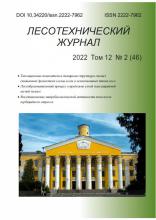Mytischi, Moscow, Russian Federation
The article presents the results of experimental and computational studies of the kinetics of thermal degradation of various types of wood in a helium environment. Kinetic parameters of thermal degradation are determined by the results of thermogravimetric experiments. Experimental setup was designed and constructed for the thermogravimetric study, which allows you to conduct research in the inert helium gas. The samples were wood shavings of various breeds. Starting chips humidity was 10 %. Steps, corresponding drying, were excluded from consideration. Heating is carried out at a constant rate of 5 K/min.
thermal degradation, thermogravimetric studies, kinetic parameters, thermally modified wood.
1. Ermochenkov M.G. Prognozirovanie svoystv termicheski modifitsirovannoy drevesiny [Predicting the properties of thermally modified wood]. Moscow State Forest University Bulletin - Lesnoi Vestnik [Bulletin MSFU - Forest Gazette] 2010, no. 4 (73), pp.111-115. (In Russian).
2. Ermochenkov M. G. Termogravimetricheskie issledovaniya kinetiki termicheskoy sushki drevesiny [Thermogravimetric study of the kinetics of thermal drying of wood]. Nauchnye trudy [Scientific works]. Moscow, 2007, pp. 36-46. (In Russian).
3. Zhigunov S.V. Teplomassoobmen i kinetika termodestruktsyi pri vysokotemperaturnom nagreve kompozitsionnyh materialov Diss. kand. tekhn. nauk [Heat and mass transfer and kinetics of thermal degradation at high temperature composite materials. Dis. PhD in Engineering]. Moscow, 1990. (In Russian).
4. Kislitsin A.N. Piroliz drevesiny: himizm, kinetika, produkty, novye protsessy [Pyrolysis of Wood: chemistry, kinetics, products, new processes]. 1990, 312 p. (In Russian).
5. Koryakin V.I. Termicheskoe razlozhenie drevesiny [Thermal decomposition of wood]. Leningrad, 1962, 678 p. (In Russian).
6. Kuvik T.E. Kinetika termicheskoy destruktsyi drevesiny v prilozhenii k prognozirovaniyu svoystv termomodifitsirovannoy drevesiny [Kinetics of thermal degradation of wood in the annex to predict the properties of wood thermomodified]. 4 Mezhdunarodnaya nauchno-prakticheskaya konferentsiya “Sovremennye energosberegaushye teplovye tehnologii (sushka и termovlazhnostnaya obrabotka materialov) SETT” [The Fourth International scientific-practical conference "Modern energy-saving heat technology (drying and hydrothermal treatment of materials) SETT”] . Moscow, 2011, Vol. 2, pp. 144-148. (In Russian).
7. Shvedov B.A. Energo- i massoobmen v materialah teplovoy zashity mnogorazovyh raketno-kosmicheskih system: diss. doct. Tekhn. Nauk [Energy and mass transfer in thermal protection materials reusable space-rocket systems. Diss. DSc in Engineering]. Moscow, 1990. (In Russian).
8. Emanuel N.M., Knorre D.G. Kurs himicheskoy kinetiki [Chemical Kinetics Course]. Moscow, 1974. (In Russian).
9. Slopiecka, Katarzyna; Bartocci, Pietro; Fantozzi, Francesco. Thermogravimetric analysis and kinetic study of poplar wood pyrolysis. 3rd International Conference on Applied Energy (ICAE) Perugia, Italy, 2011, Applied energy, 2012, Vol. 97, Is. pp. 491-497.
10. Grieco, Enrico; Baldi, Giancarlo. Analysis and modelling of wood pyrolysis. Chemical engineering science, 2011, Vol. 66, Is. 4, pp. 650-660. DOI: https://doi.org/10.1016/j.ces.2010.11.018; EDN: https://elibrary.ru/OBDTKH
11. Ranzi, Eliseo; Corbetta, Michele; Manenti, Flavio. Kinetic modeling of the thermal degradation and combustion of biomass. Chemical engineering science, 2014, Vol. 110, pp. 2-12.
12. Sarvaramini A., Assima Gnouyaro P., Larachi F. and etc. Dry torrefaction of biomass - Torrefied products and torrefaction kinetics using the distributed activation energy model. Chemical engineering journal, 2013, Vol. 229, pp. 498-507.
13. Petrissans A., Younsi R., Chaouch M. and etc. Wood thermodegradation: experimental analysis and modeling of mass loss kinetics. Maderas-ciencia y tecnologia, 2014, Vol. 16, Is. 2, pp. 133-148. DOI: https://doi.org/10.4067/S0718-221X2014005000011; EDN: https://elibrary.ru/YEHVAN
14. Yu Hongbo, Liu Fang, Ke Ming and etc. Thermogravimetric analysis and kinetic study of bamboo waste treated by Echinodontium taxodii using a modified three-parallel-reactions model. Bioresource technology, 2015, Vol. 185, pp. 324-330.












